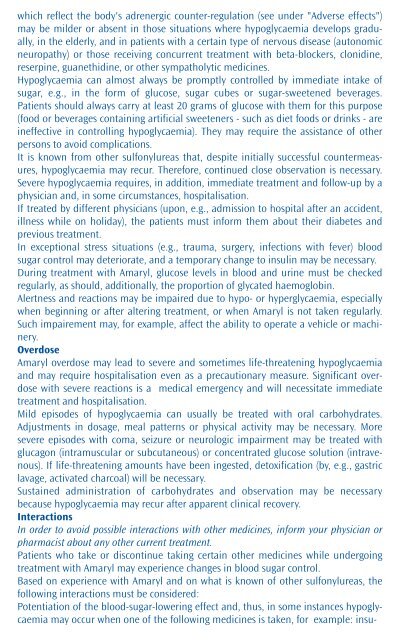Amaryl (glimepiride) Leaflet - Sanofi
Amaryl (glimepiride) Leaflet - Sanofi
Amaryl (glimepiride) Leaflet - Sanofi
Create successful ePaper yourself
Turn your PDF publications into a flip-book with our unique Google optimized e-Paper software.
which reflect the body's adrenergic counter-regulation (see under "Adverse effects")<br />
may be milder or absent in those situations where hypoglycaemia develops gradually,<br />
in the elderly, and in patients with a certain type of nervous disease (autonomic<br />
neuropathy) or those receiving concurrent treatment with beta-blockers, clonidine,<br />
reserpine, guanethidine, or other sympatholytic medicines.<br />
Hypoglycaemia can almost always be promptly controlled by immediate intake of<br />
sugar, e.g., in the form of glucose, sugar cubes or sugar-sweetened beverages.<br />
Patients should always carry at least 20 grams of glucose with them for this purpose<br />
(food or beverages containing artificial sweeteners - such as diet foods or drinks - are<br />
ineffective in controlling hypoglycaemia). They may require the assistance of other<br />
persons to avoid complications.<br />
It is known from other sulfonylureas that, despite initially successful countermeasures,<br />
hypoglycaemia may recur. Therefore, continued close observation is necessary.<br />
Severe hypoglycaemia requires, in addition, immediate treatment and follow-up by a<br />
physician and, in some circumstances, hospitalisation.<br />
If treated by different physicians (upon, e.g., admission to hospital after an accident,<br />
illness while on holiday), the patients must inform them about their diabetes and<br />
previous treatment.<br />
In exceptional stress situations (e.g., trauma, surgery, infections with fever) blood<br />
sugar control may deteriorate, and a temporary change to insulin may be necessary.<br />
During treatment with <strong>Amaryl</strong>, glucose levels in blood and urine must be checked<br />
regularly, as should, additionally, the proportion of glycated haemoglobin.<br />
Alertness and reactions may be impaired due to hypo- or hyperglycaemia, especially<br />
when beginning or after altering treatment, or when <strong>Amaryl</strong> is not taken regularly.<br />
Such impairement may, for example, affect the ability to operate a vehicle or machinery.<br />
Overdose<br />
<strong>Amaryl</strong> overdose may lead to severe and sometimes life-threatening hypoglycaemia<br />
and may require hospitalisation even as a precautionary measure. Significant overdose<br />
with severe reactions is a medical emergency and will necessitate immediate<br />
treatment and hospitalisation.<br />
Mild episodes of hypoglycaemia can usually be treated with oral carbohydrates.<br />
Adjustments in dosage, meal patterns or physical activity may be necessary. More<br />
severe episodes with coma, seizure or neurologic impairment may be treated with<br />
glucagon (intramuscular or subcutaneous) or concentrated glucose solution (intravenous).<br />
If life-threatening amounts have been ingested, detoxification (by, e.g., gastric<br />
lavage, activated charcoal) will be necessary.<br />
Sustained administration of carbohydrates and observation may be necessary<br />
because hypoglycaemia may recur after apparent clinical recovery.<br />
Interactions<br />
In order to avoid possible interactions with other medicines, inform your physician or<br />
pharmacist about any other current treatment.<br />
Patients who take or discontinue taking certain other medicines while undergoing<br />
treatment with <strong>Amaryl</strong> may experience changes in blood sugar control.<br />
Based on experience with <strong>Amaryl</strong> and on what is known of other sulfonylureas, the<br />
following interactions must be considered:<br />
Potentiation of the blood-sugar-lowering effect and, thus, in some instances hypoglycaemia<br />
may occur when one of the following medicines is taken, for example: insu-



